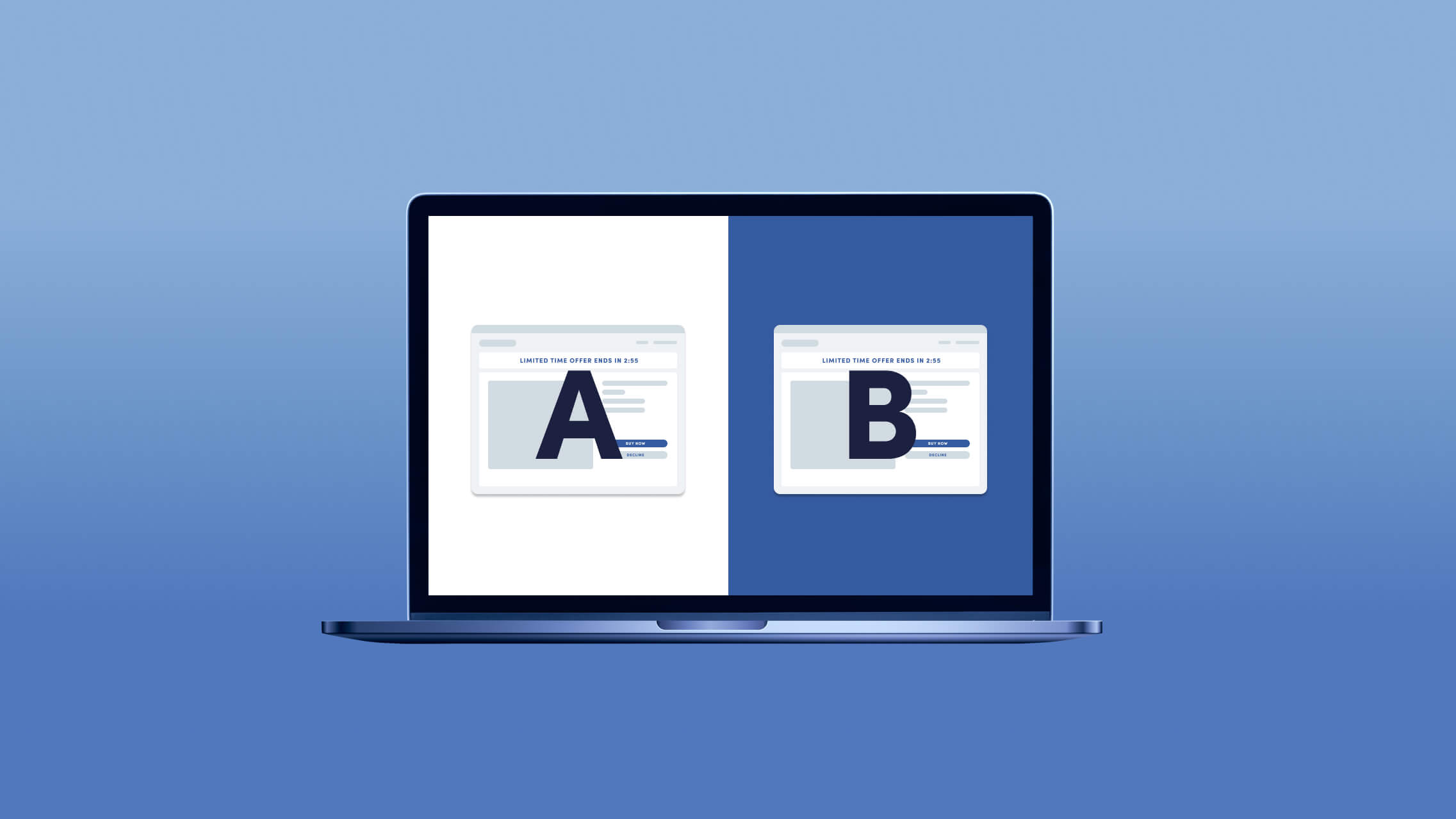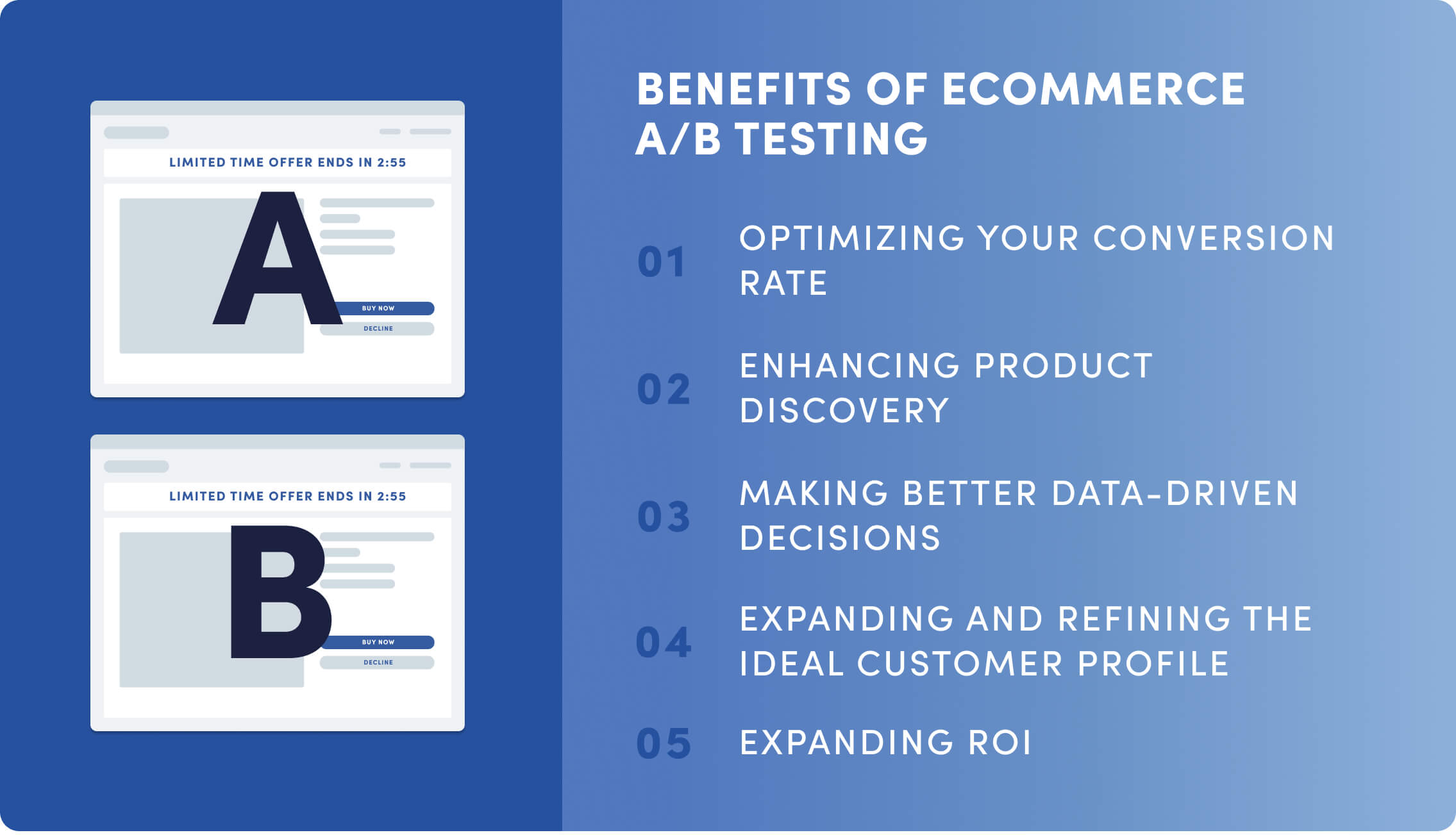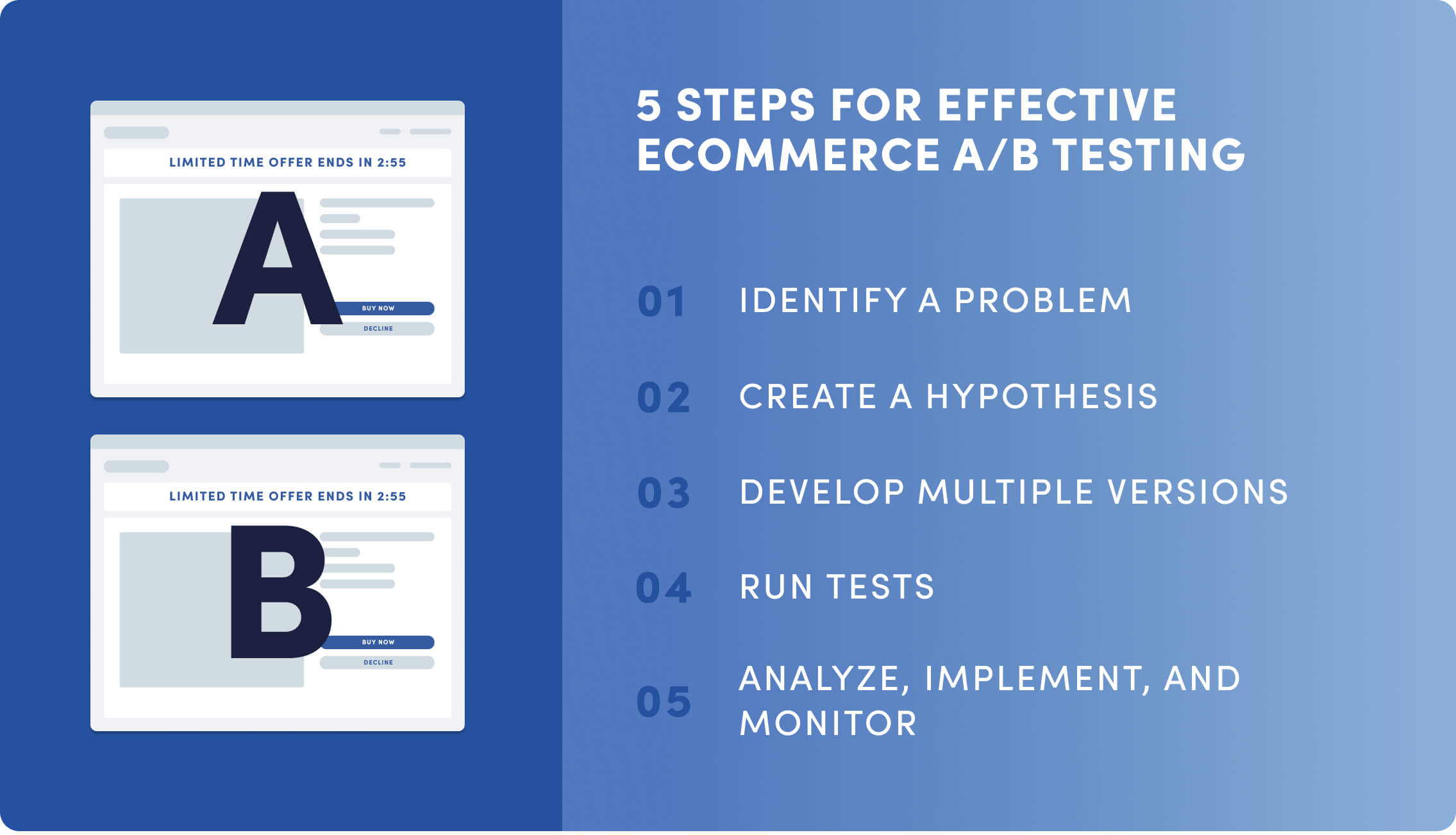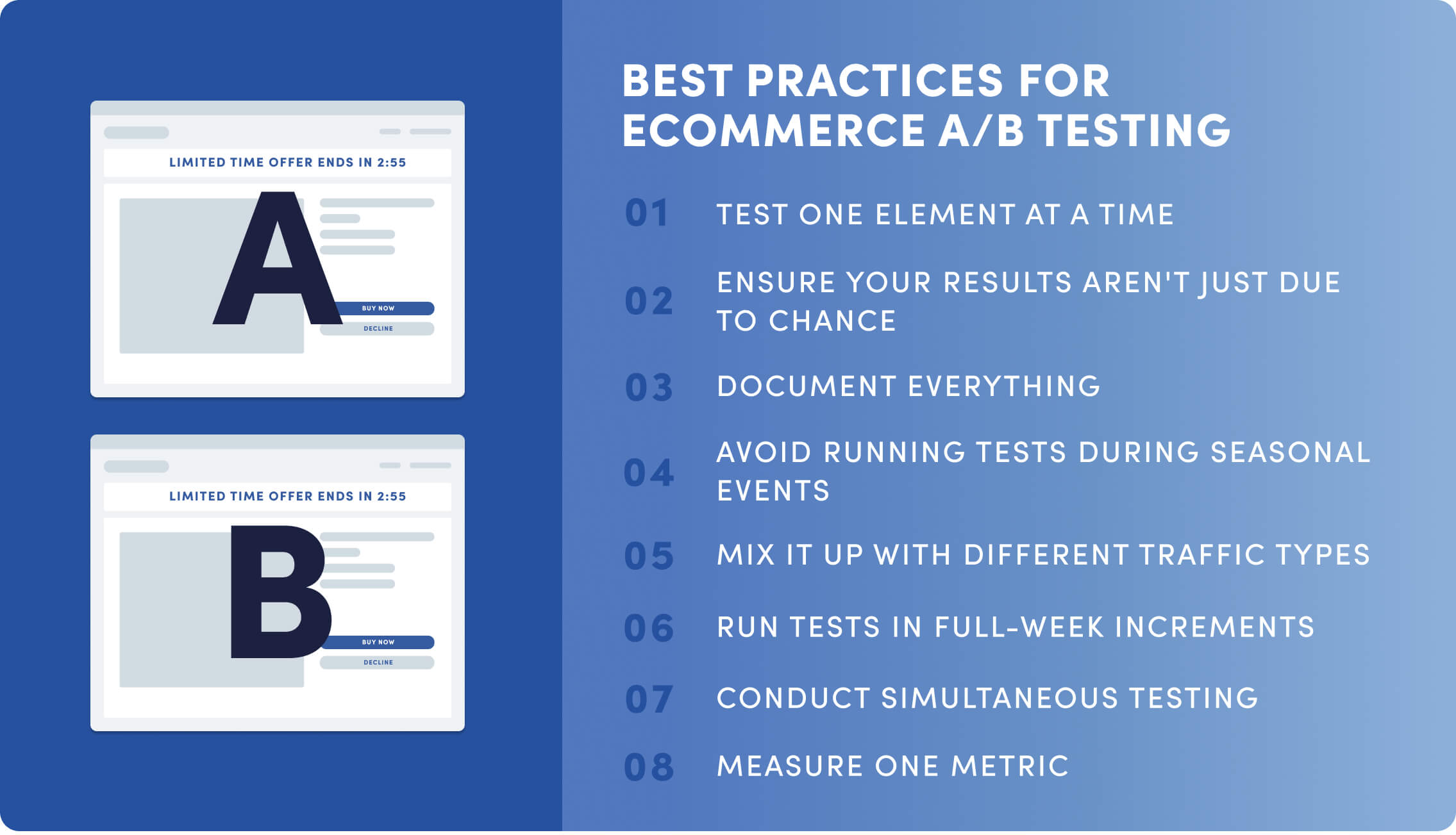Ecommerce Personalization: The Complete Guide for Founders, Merchants, and Marketers
Your ecommerce personalization journey starts here👇

Unlock the power of ecommerce A/B testing to optimize your online store, boost conversion rates, and enhance the shopping experience.
ABT: Always Be Testing for ecommerce success. In the highly competitive world of ecommerce, continuously testing and optimizing your website is crucial for staying ahead. A/B testing allows you to fine-tune your site based on specific metrics, improving conversion rates, and creating an enjoyable shopping experience.
Benefits of ecommerce A/B testing include optimizing conversion rates, enhancing product discovery, making data-driven decisions, refining your ideal customer profile, and ultimately increasing ROI. Ecommerce A/B Testing a powerful tool for personalizing and improving the customer experience.
Key areas to conduct ecommerce A/B testing include the homepage and landing pages, product detail pages, category pages, the shopping cart, checkout pages, and post-purchase offers. Testing these areas can lead to significant improvements in user engagement and sales.
In the world of sales, "ABC: Always Be Closing" reigns supreme. But in the ecommerce world, "ABT: Always Be Testing" should be law.

The online retail space is bigger than ever, and the battle to catch the consumer's eye has never been more intense.
The key to staying ahead? Continuously test and optimize your ecommerce website.
Whether it's a product page layout, a checkout process, or product recommendation widgets, testing various elements of your online store can make the difference between a sale and a bounce.
By consistently examining what works and what doesn't, you can tailor your ecommerce site to meet the ever-changing needs and preferences of your customers.
The goal is not only to make a sale but also to create an enjoyable shopping experience that keeps customers coming back time and time again.
Here in our "Ultimate Ecommerce A/B Testing Guide," we’ll walk you through how to conduct robust A/B tests and reveal actionable insights that you can apply right away.
So get ready to learn your ABTs!
Table of Contents
Five Steps to Effective A/B Testing
Best Practices for Ecommerce A/B Testing
Ecommerce A/B testing, also known as split testing, is a methodology used to determine the optimal option in a given situation. It involves pitting two versions of a webpage or feature against each other to determine which one performs better based on specific metrics. This can be conversion rates, click-through rates, or any other relevant ecommerce metric.
Let's say you have an online store, and you're not sure which is better: showing personalized product recommendations or general top-selling products on the product page. You can use A/B testing to show personalized recommendations to some visitors and top-selling products to others. By comparing conversion rates or engagement rates between the two, you can see which option your customers prefer.
Now, here's where a lot of people get tripped up. A/B testing isn't the same as multivariate testing. A/B testing looks at one change at a time by comparing two versions of a page. Multivariate testing looks at multiple changes together to see how they affect user behavior.

Seventy-three percent of shoppers expect brands to understand their unique needs and expectations. If you're not A/B testing, you're missing out on vital insights that could help you personalize and enhance the customer experience, as well as the following benefits.
The primary goal for most ecommerce A/B testing is to improve conversion rates. You can test how different changes will affect conversion rates by experimenting with variables like layout, design, copy, and call-to-action. By playing around with these elements, you'll turn more window shoppers into paying customers.
Showing different groups of customers varying products or layouts can help you learn what appeals to them the most. It's about finding that winning formula that makes your products irresistible to them. This leads to a more refined product selection, making it easier for your customers to find the gems they're after. It's not just testing; it's engaging and learning.
You're running a business, not a guessing game. Instead of relying on hunches, ecommerce A/B testing allows you to make decisions backed by solid, actionable data. When you run tests, you can gather real, quantifiable data on what customers prefer. The result is more effective strategies that actually resonate with your customers’ needs and wants.
By testing various ecommerce features, you can find out what appeals most to your target audience. With this information, you can better adjust your ecommerce merchandising strategy to suit your target customer. The outcome is better customer experiences, smoother online shopping journeys, and a bigger bottom line.
Speaking of the bottom line, every dollar matters. A/B testing lets you see what's hitting home with your customers, so you're putting your money into what genuinely works. This helps you avoid throwing cash down the drain and ensures that you use resources effectively to satisfy more customers and make more profit.
There are six key areas of your ecommerce website where you should A/B test product recommendation widgets. The test results will help you fine-tune their effectiveness, discover what resonates best with your customers, and make data-driven decisions that enhance the shopping experience and increase sales.
.jpg?width=2271&height=1303&name=B%20Testing%20Guide_In%20Blog%20Image_2%20(comp).jpg)
Think of the homepage and landing pages of your ecommerce site as the front door to your online business. And you can make that entrance more appealing through A/B testing.
For example, you can experiment with where you place your CTA buttons, social media links, and the entire flow of the user experience. Try playing around with where you position recommendation widgets — above the fold, below the fold, etc.
If the homepage is the front door to your online business, then the product detail page is the guided tour that leads customers to exactly what they're looking for. Optimizing product pages and product descriptions can significantly impact your ecommerce conversion rate. This includes testing product images, pricing strategies, call-to-action (CTA) buttons, and page layout. It's a good idea to also compare different recommendation algorithms for suggesting related products.
Collection pages guide users to specific product groups, helping them find a selection that suits their interests. This helps turn general curiosity into specific intent. It's the bridge between browsing and buying, where you help customers find not just a product but the right product.
On this page, you can test recommendations based on previous browsing, purchasing behavior, and more. You can also experiment with the size of images, color scheme, and layout.
According to the Baymard Institute, the average cart abandonment rate is 70.19%. That's 70% of customers leaving your online store without buying anything. A/B testing the shopping cart can help you identify and fix issues that are causing those customers to bounce.
For example, you can try these A/B tests:
The checkout page is a crucial point in the conversion funnel. It's where all the efforts in engaging and convincing the customer come together. A smooth, user-friendly checkout process can seal the deal, while complications or uncertainties can lose a sale in an instant.
That's why A/B testing the checkout page is so vital. Try experimenting with different layouts, forms, or payment methods to pinpoint what works best for your audience.
Post-purchase offers are the secret weapon for enhancing customer retention, increasing order value, and fostering long-term loyalty by providing targeted incentives and personalized recommendations immediately after a sale. (After an order is completed but before the Thank You page). To encourage your customers to return and spend more, try testing different offers, messages, and positions.
For example, test the timing and design by comparing widget recommendations immediately after purchase with those in follow-up emails. You can also compare offering related products, accessories, or subscription-based recommendations within the widgets.
Now here's where we get to the nitty-gritty. Follow these steps to A/B test like a pro and enhance the performance of your ecommerce site.

Start by identifying the problem or challenge you're facing with your online store. Dive into the things that need fixing because that's where you're going to make the biggest impact.
To zero in on the problem, ask open-ended questions related to A/B testing like: "What trends are we noticing across our store right now? What are we trying to fix? Is it about a specific product, or is it something bigger?"
Once you've got those insights, formulate a clear statement to define the problem. Here's an example:
“Customers aren't adding anything else to their cart after adding our hero product.” This statement is the foundation for your A/B testing. It will guide the direction of your experimentation and solutions.
Once you've identified the problem, propose a hypothesis to validate and solve it. It should be testable and measurable and written in a way that you can prove right or wrong.
For example, let's continue with the problem we established in Step 1. The hypothesis might be something like this: "If we show relevant product recommendations directly below the product description, we will boost product discovery and AOV."
See what we did there? It's actionable, it's specific, and it's designed to lead to tangible results that you can track and analyze.
Next, develop multiple versions or variations to test based on your hypothesis. Having variations allows you to pinpoint what specifically resonates with your audience. You can isolate which features or designs lead to better engagement, click-through rates, or other desired outcomes.
Variations also allow you to compare and contrast different approaches, using data to make decisions instead of relying on gut feelings. It's like having multiple paths to a destination and methodically finding out which one is the fastest and most efficient.
To test the hypothesis of showing product recommendations below the description, try using different widgets. This could give useful insights to boost product discovery and AOV. Here are some variations:
Using these variations in your testing strategy can provide valuable insights and help you optimize the overall user experience
Now that you've got your hypothesis and variants, the next step is to run your tests! First, think about what your goals are for the experiment. Are you trying to identify which variant performs better, or are you trying to test the effects of a certain variable? Once you've determined your goals, you can start to design the experiment.
For example, let's say we want to look at how the carousel widget will perform versus the grid view widget. Here's what the test would look like:
Determine which layout (carousel or grid view) leads to more items added to the cart, ultimately boosting AOV.
Segment audience: Divide the traffic equally between the three groups: control, carousel, and grid view. The control group is just your current setup, minus the carousel or grid view widget. By having this control group, you can accurately measure the impact of the carousel and grid view variations. This will isolate the effects of these changes.
Monitor user behavior: Use tracking tools like Hotjar or Crazy Egg, which offer heatmaps, to observe how users interact with both widget types. These heatmaps show where users click, move, and scroll on the page. Additionally, you can use these tools to measure conversion rates and other metrics. By tracking the different user behaviors, you can gain insight into the effectiveness of the carousel and grid view variations. Knowing how users interact with each widget type can help you determine which variation to keep or discard.
🔬 Rebuy users can easily test on-site personalization solutions with Rebuy A/B Testing.
You've run the tests and collected the data — now it's time to make some serious sense of it. Examine the quantitative data from the test to see how the two versions performed against each other. It's also important to look at qualitative feedback from users to gain a better understanding of the user experience.
Additionally, while understanding the “what” is great, the “why” is where the magic happens. Why did one variation resonate with the audience while another fell flat? Was it the design, the placement, the content? Dive into the user interactions and figure out what made the difference. This creates a learning opportunity for all future experiments and decisions.
Finally, apply the winning version to your ecommerce site. Then continue to monitor performance and be prepared to iterate when necessary. By keeping that cycle of testing, learning, and improving rolling, you'll stay ahead of the curve and keep delivering value to your audience.
To ensure the most accurate and actionable results from your ecommerce A/B testing, consistency, rigorous methodology, and thoughtful analysis is the name of the game. Here are some best practices to follow.

While multivariate testing is an option, if you want the best results, focus on changing and testing a single element. This method isolates the effect of a particular change, so you can better understand how it affects user behavior and other key metrics.
When you change multiple variables at the same time, it can be hard to know which one caused the differences in performance.
Statistical significance is crucial because it ensures that the results of a test are reliable and not simply due to chance. It's not just about seeing a change; it's about knowing that the change is real and repeatable. This requires a sufficient number of visitors to see all variations of the test. By using appropriate sample sizes, you can confidently interpret your results and make sound, data-driven decisions for your business.
Many A/B testing tools have built-in calculators to help you find the right sample size for each test variation.
Keep track of every little detail! Every test, every hypothesis, method, data point, conclusion, and action taken — write it all down. This builds a knowledge base for future reference.
This kind of documentation is key to making your future tests consistent. It helps you understand what you've already done and what results you've achieved. More than that, it keeps you from going down the same unsuccessful paths or retreading old ground.
Running tests during seasonal events can lead to inaccurate results. Seasonally high traffic, such as during the holiday season, can skew the test outcomes. What could possibly go wrong? Well, if you use those numbers to make decisions later on when traffic is back to normal, you might find that what worked during the crazy rush doesn't perform well under average traffic conditions.
To avoid these problems, plan your tests outside of periods with significant seasonal fluctuations. This ensures the results are not influenced by temporary spikes in traffic.
Don't just stick to one lane — include a mix of traffic types, like paid and organic. This creates a more representative sample of your typical audience and helps you understand different user behaviors. It also reduces the risk of biased results that may arise from relying solely on one traffic source.
Conduct tests for complete weeks rather than shorter timeframes. To get consistent results, we recommend running your A/B test for 1-2 weeks or even a couple of business cycles. This approach captures more traffic patterns and accounts for daily variations. By doing this, you get a real read on your audience rather than a snapshot.
When conducting A/B tests, run the different variations at the same time, not one after the other. Why? Because it prevents external factors such as time-based events or SEO updates affecting the results.
For example, when testing two CTA buttons on your product page, run both at once to ensure equal exposure to the same conditions. Maybe there's a big trend going on in your industry, or you've got a huge marketing push happening. By running them together, you know that any difference in how they perform is all down to the changes you made, not some random outside factor.
Don't allow yourself to get bogged down by too many metrics when you're testing. Using multiple metrics skews the hypothesis, muddies the results, and increases the chances of receiving a false positive. Focusing on a single metric ensures you stay focused on what matters.
Let's say you're rolling out a new checkout design to increase conversion rates. Make that your primary metric. While it's good to keep tabs on other metrics like time on page or customer satisfaction, don't let those side-track you. They're supplementary insights, not the main event. Your decision on that new design should rest solely on the conversion rate. Keep it simple and focused, and you'll have a clearer picture of what's working and what's not.
Your ecommerce personalization journey starts here👇
To succeed in the ecommerce game, a relentless commitment to optimization is essential. That's why we believe "always be testing" isn't just a catchphrase — it's a core principle that leads to continuous growth and success.
But optimization doesn't have to be time-consuming or cumbersome. With Rebuy, you can continuously test merchandising widgets by quickly building experiments to track performance and impact. Setting up experiments is a breeze and can be done in less than 5 minutes.
Learn more about Rebuy A/B Testing.
In the ever-evolving landscape of ecommerce, the race to capture and retain customers has never been fiercer. Amidst a cacophony of digital advertisements, pop-ups, and social media campaigns, one method stands out for its subtle effectiveness: A/B testing.
Interested in partnering with Rebuy? Let's do it.
To keep up with the latest trends, platform updates, and more, follow us on LinkedIn.
Recover lost sales and enhance conversions with our 6 proven tips for an effective cart abandonment recovery strategy. Perfect for Shopify stores.
Here are four surefire ways to use personalized product recommendations to increase conversions, retain customers and boost average order value.
Stop the (cart abandonment) madness! Discover 7 ways to improve your Shopify cart optimization strategy.
Stay up to date with all things Rebuy by signing up for our newsletter.
